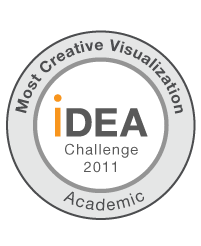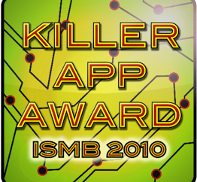GenomeView 1514: short reads and coverage
Thu, 04/07/2011 - 16:48 — Thomas AbeelIn this release of GenomeView the visualization of individual short reads, as well as coverage plots has been significantly improved.
With directional RNA-seq the read sense is now visually indicated, even for paired-end data. Hovering over individual reads will show detailed information about each read. When reads of a pair overlap, this is visually indicated.
GenomeView 1415: Controlling GenomeView with JavaScript
Tue, 03/01/2011 - 23:58 — Thomas AbeelThe main new feature we want to highlight in this release is the ability to control the GenomeView applet from the webpage in which it is embedded using JavaScript. The details are laid out in the integration manual. In short you can use JavaScript to load data and move around in GenomeView. In this context we have also made available a minimal applet that has no menu or side bar.
Furthermore, several options to alter the appearance of GenomeView on start-up have been added.
GenomeView 1370: preloaded data and searching
Mon, 02/07/2011 - 22:41 — Thomas AbeelRelease 1370 focuses on making the first-time-user experience a lot more agreeable by providing the Genome Explorer.
Genome Explorer is a portal to a set of instances of GenomeView with preloaded data. When you start GenomeView you will now be presented with the Genome Explorer which allows you to load data from a number of genomes. For now, we provide a number of tutorial genomes which illustrate a number of features of GenomeView.
GenomeView 1320: remote pile-ups
Mon, 01/24/2011 - 23:53 — Thomas AbeelRelease 1320 fixes a number of bugs that prevented pile up tracks from showing up when loading them from a URL. Under the hood, we are also working on getting the indexing done on multiple alignment files, so expect more on that in the next release.
Training: NGS Data Basics and Visualisation with GenomeView
Fri, 12/03/2010 - 14:55 — Thomas AbeelIn collaboration with VIB BITS there will be a workshop on "NGS Data Basics and Visualisation with GenomeView". This training course takes place in Gent, Belgium on December 7, 2010.
Currently, the course if fully booked, but you can pre-register for the next GenomeView course organized by BITS.
GenomeView 1305: improving performance and fixing bugs
Tue, 11/30/2010 - 11:20 — Thomas AbeelIn releases 1295 and 1305 we have made some more improvements to the rendering speed of some tracks, in particular when a lot of data is on screen. Furthermore, we have improved the visual clues when not all data can be displayed. Besides improving the speed, we have also fixed a number of bugs and implemented some smaller feature requests:
- Menu action to extent to the next start codon
- Configuration option to have all possible start codons considered, or just ATG
- The order species appear in a multiple alignment can now be configured
GenomeView 1255: NGS improvements
Wed, 11/17/2010 - 12:06 — Thomas AbeelIn release 1255 we have improved the performance and visual representation of the short read track and the pile up track.
The short read track now also displays the connection lines properly for spliced reads when zoomed out.
The pileup track now has a pop-up with detailed information about the read coverage and polymorphisms at a particular site.
GenomeView 1227: forward and reverse coverage
Fri, 10/22/2010 - 10:16 — Thomas AbeelThe latest snapshot of GenomeView has some new features as well as a number of bug fixes.
The main novelty is the improved pile-up tracks. The pile-up track can now show the coverage information from forward and reverse reads separately. This makes inspection of Chip-Seq data easier than ever.
GenomeView 1198: Indexed data sources and applets
Thu, 09/23/2010 - 12:40 — Thomas AbeelWe are pleased to announce that we have released a new version of GenomeView which includes a huge number of improvements.
- Support more file formats
- Support for indexed file formats created by SAMtools (tabix, faidx). This required a redesign of the data handling framework.
- GenomeView is now also available as Applet and as JComponent for integration in other websites and tools.
- Simplified GUI significantly
- Asynchronous data fetching for some data types, this will be expanded on in the future
GenomeView wins ISMB Killer App Award 2010
Wed, 09/08/2010 - 15:45 — Thomas Abeel At ISMB 2010, the first ‘Killer App Award’ for the individual or team with a tool or system judged to be of most practical benefit to biochemists and/or molecular biologists was awarded.
At ISMB 2010, the first ‘Killer App Award’ for the individual or team with a tool or system judged to be of most practical benefit to biochemists and/or molecular biologists was awarded.
To be eligible for the Killer App Award, a system or tool must be fully functional, and must be presented at the ISMB conference as a poster or talk. (see Criteria)
Submissions are reviewed by a panel of judges from biochemistry, molecular biology, bioinformatics, and from pharmaceutical industry. Four finalists were invited to give a short talk about their application at ISMB.
GenomeView won the first prize!



